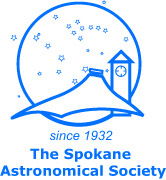
- This event has passed.
August Meeting
August 9, 2024 @ 6:30 pm - 9:30 pm
We are hosting Professor Shane Larson from Northwestern University in Chicago for the August 9th Meeting at 7:30 pm. The event is at the “Party Palace” located at 8616 N Lehman Road, just north of Bigelow Gulch Road. The club pot-luck “feeding before the meeting” starts about an hour before, at 6:30 pm.
The Dark Side of the Universe: Dark matter and dark energy in the galaxy and Cosmos
The Cosmos abounds with matter that emits copious amounts of light, both in the spectrum of visible colors we perceive with our eyes as well as in invisible light such as x-rays and radio waves. But in the latter half of the 20th Century we discovered that a significant part of the Universe is filled with matter that doesn’t emit ANY light at all. In the last two decades, we have discovered an even more mysterious material that appears to be driving changes in the scale of the Universe.
These dark influences are known as “dark matter” and “dark energy”, and can only be perceived by their gravitational influence on all the bright, shining matter we know and love. In this talk we’ll discuss why we think the dark matter and dark energy are out there, and explore some of the ideas we have for discovering just what it might be.
 Shane Larson is a research professor of physics at Northwestern University, where he is the Associate Director of CIERA (Center for Interdisciplinary Exploration and Research in Astrophysics). He works in the field of gravitational wave astrophysics, specializing in studies of compact stars, binaries, and the galaxy. He works in gravitational wave astronomy with both the ground-based LIGO project, and future space-based observatory LISA.
Shane Larson is a research professor of physics at Northwestern University, where he is the Associate Director of CIERA (Center for Interdisciplinary Exploration and Research in Astrophysics). He works in the field of gravitational wave astrophysics, specializing in studies of compact stars, binaries, and the galaxy. He works in gravitational wave astronomy with both the ground-based LIGO project, and future space-based observatory LISA.
He was formerly a tenured associate professor of physics at Utah State University. He is an award winning teacher, and a Fellow of the American Physical Society. He is an avid amateur astronomer, observing with two homebuilt Dobsonians, a 12.5″ named EQUINOX and a 22″ named COSMOS MARINER. He contributes regularly to a public science blog at writescience.wordpress.com, and tweets with the handle @sciencejedi .
